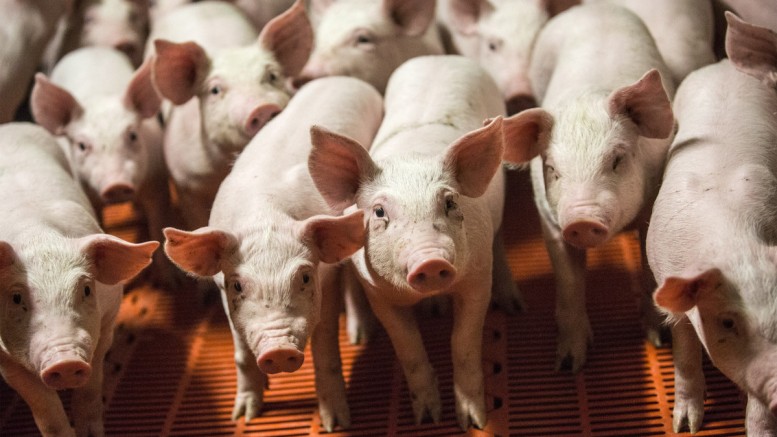One of Justice Antonin Scalia’s chief policy concerns — some might call it an obsession — was class actions, which he saw as excuses for plaintiffs’ lawyers to make money by aggregating small individual claims to the detriment of corporate defendants. On Tuesday the U.S. Supreme Court hinted that, in Scalia’s absence, class-action law might not continue to be interpreted narrowly. It cautiously upheld the use of representative sampling as evidence for common claims among plaintiffs — a small but meaningful victory for class actions in a decision that, under the precedent established by Scalia, might’ve gone the other way.
The case, Tyson Foods v. Bouaphakeo, is a fairly ordinary one. It involves the classic labor-law question of compensation for time spent putting on and taking off protective gear, in this instance by workers killing hogs and trimming pork products at Tyson’s plants in Iowa. The Supreme Court has been considering such “donning and doffing” cases since before 1947, when Congress passed the Portal-to-Portal Act requiring pay for preparation that is “integral and indispensable” to the job.
Yet somehow, some 80 years after the birth of modern labor law, employers such as Tyson still want to avoid paying workers for time spent doing things necessary to do their jobs.
Tyson paid some, but not all, of its workers for four to eight extra minutes of work for putting on and taking off protective gear. It never kept records of how long it took individual employees to don and doff.
When the workers brought suit, they had no way of knowing exactly how much each of them was owed. But they sued en masse anyway.
To get certified by the court as a class, the worker-plaintiffs had to prove, in the words of the definitive treatise quoted by the court, that “the same evidence will suffice for each member to make a prima facie showing [that] the issue is susceptible to generalized, class-wide proof.” That means that to avoid thousands of separate suits and get a court to decide their cases all at once, the workers had to show that they didn’t need to provide separate evidence in every case but could rely on proof common to all.
To do that, the plaintiffs offered a study done by an industrial-relations expert. It drew on a representative sample of 744 observations of workers, and concluded that, on average, it took trimming workers 18 minutes to put and on and take off gear, and 21.25 minutes for workers in the hog-killing department.
Tyson argued that the differences among individual workers rendered the case unsuitable for a class action. As precedent, it relied on a Scalia classic, the 2011 Wal-Mart v. Dukes decision. In that case — considered a landmark — the court refused to consider 1.6 million female Wal-Mart workers as a class for purposes of their allegations of sex discrimination.
The core of the 5-4 Wal-Mart opinion was Scalia’s conclusion that the Wal-Mart employees’ claims were too disparate to count as a common question of fact or law. Tyson said that principle applied to their suit.
Justice Anthony Kennedy wrote Tuesday’s decision for a 6-2 majority that included the liberals as well as Chief Justice John Roberts. He distinguished the Wal-Mart case sharply. That precedent, he said, “does not stand for the broad proposition that a representative sample is an impermissible means of establishing classwide liability.”
Instead, Kennedy reasoned, a representative sample is, like all evidence, “a means to establish or defend against liability.” A sample is perfectly admissible to establish a common class provided it’s a good piece of statistical analysis.
This narrowing of Wal-Mart would never have satisfied Scalia, who would no doubt have dissented sharply and maybe carried Kennedy with him. With no Scalia, the decision stood criticized only by Justices Samuel Alito and Clarence Thomas, who dissented but without Scalia’s brio.
Roberts couldn’t resist a clever move of his own in his separate concurrence. He noted that the court didn’t decide how damages should be allocated, remanding that issue to the lower court. Then he offered free advice to Tyson. He suggested that there would be no way to use the representative sample to decide who exactly should get what damages, and that damages must be allocated based on actual injury, not a statistical average. Otherwise, Roberts concluded, the jury verdict might have to be thrown out anyway, on the grounds that it couldn’t withstand logical scrutiny with respect to damages.
Roberts is a brilliant doctrinalist, and his argument is certainly clever. Of course it could be answered by saying that if statistics are good enough for proof, they should be good enough for damages. That’s certainly common sense. But it might not be doctrine, which sadly isn’t always the same thing.
Yet notwithstanding the possibility that the verdict may still be struck down on remand or on appeal back to the Supreme Court, Tuesday’s decision is still a modest win for class actions. Post-Scalia, class-action lawyers are no longer faced with the mace that was Scalia — even if they must still deal with the rapier that is Roberts.
That’s from my colleague and friend William Rubenstein’s “Newberg on Class Actions,” which the court (and everyone else) treats as gospel on the topic.
This column does not necessarily reflect the opinion of the editorial board or Bloomberg LP and its owners.
To contact the author of this story:
Noah Feldman at [email protected]
To contact the editor responsible for this story:
Brooke Sample at [email protected]
Source: www.bloombergview.com





Be the first to comment on "Class-Action Suits Have a Shot in Post-Scalia Era"